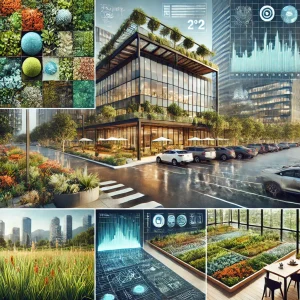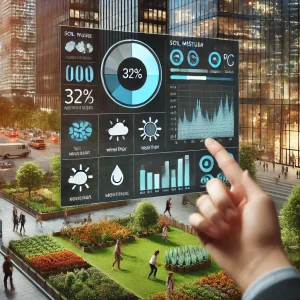Commercial landscapes must evolve to withstand new environmental challenges as climate change accelerates. From extreme heat waves and droughts to increased flooding and unpredictable seasonal shifts, businesses must rethink their outdoor spaces to ensure sustainability, cost efficiency, and long-term resilience. Fortunately, innovative landscaping solutions—such as drought-resistant plantings, permeable paving, smart irrigation, and AI-driven climate monitoring—offer pathways to creating landscapes that not only survive but thrive in a changing climate.
The Evolution of Climate-Resilient Landscaping
In the past, commercial landscapes prioritized aesthetics over environmental adaptability. Expansive, non-native lawns, high-maintenance plant beds, and inefficient irrigation systems dominated urban and suburban business spaces. These landscapes required significant water, energy, and chemical inputs—practices that are no longer viable in the face of water shortages and rising temperatures.
Today, businesses embrace sustainable landscape design principles that reduce resource consumption and enhance ecological benefits. Strategies such as xeriscaping, green infrastructure, and smart technology replace traditional approaches, allowing commercial properties to withstand climate stress while maintaining aesthetic appeal.
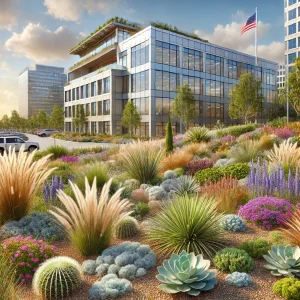
Challenges in Implementing Climate-Resilient Landscapes
Transitioning to climate-resilient landscapes comes with challenges. Businesses often face budget constraints, regulatory hurdles, and the need to maintain an inviting aesthetic for clients and employees. Additionally, some property owners hesitate to adopt new landscaping technologies due to maintenance costs and system reliability concerns.
However, the long-term benefits—including reduced water bills, lower maintenance costs, and enhanced property value—often outweigh the initial investment. Educating commercial property owners on climate-smart landscapes,’ return on investment (ROI) is key to widespread adoption.
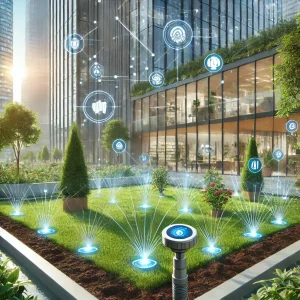
Key Strategies for Climate-Resilient Commercial Landscaping
1. Drought-Resistant Plantings
Replacing traditional grass lawns with drought-tolerant native plants, succulents, and deep-rooted perennials can significantly reduce water usage while improving biodiversity. Native plants require minimal maintenance and are naturally adapted to local climate conditions.
Example: IslandEarth Landscape Company has successfully integrated native grasses and drought-resistant perennials into corporate campuses in British Columbia, reducing irrigation needs by over 40%.
2. Permeable Paving and Rainwater Management
Traditional concrete and asphalt surfaces contribute to urban flooding by preventing water absorption. Permeable paving solutions—such as porous asphalt, interlocking pavers, and gravel grids—allow rainwater to seep into the soil, reducing runoff and replenishing groundwater.
In addition, bioswales and rain gardens help manage excess rainwater by directing it into vegetation-rich areas that filter and absorb pollutants.
Example: Businesses in Victoria, BC, increasingly implement bioswales and green parking lots to manage heavy rainfall events, ensuring commercial landscapes can handle extreme weather fluctuations.
3. Smart Irrigation and Water Conservation
Water scarcity is a growing concern for commercial landscapes. Smart irrigation systems, which adjust watering schedules based on real-time weather data, soil moisture levels, and plant needs, significantly reduce water waste. AI-driven irrigation technology can prevent overwatering while ensuring plants receive the exact amount of moisture they need.
Example: IslandEarth Landscape has integrated AI-powered irrigation controllers into commercial landscapes across British Columbia, cutting water usage by 50% while maintaining lush greenery.
4. AI and Climate-Monitoring Tools
Advanced technology now plays a crucial role in climate-resilient landscaping. AI-driven garden planning apps and climate-monitoring sensors help businesses adapt their landscape strategies based on changing conditions. These tools analyze local weather patterns, soil health, and plant stress indicators to optimize care.
Example: Several commercial developments in Vancouver are testing sensor-based soil monitoring to detect moisture levels and nutrient deficiencies, allowing for precise fertilization and irrigation adjustments.
5. Green Infrastructure and Living Walls
Green roofs, living walls, and urban tree canopies help mitigate the urban heat island effect, improve air quality, and reduce building energy consumption. These features also create visually appealing, employee-friendly outdoor environments.
Example: In British Columbia, shopping centers and corporate buildings incorporate vertical gardens to provide natural insulation and cooling effects while promoting biodiversity in urban areas.
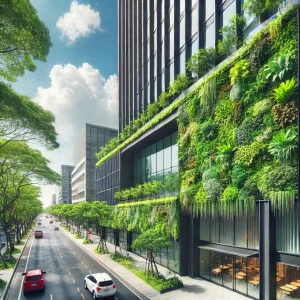
The Future of Climate-Resilient Commercial Landscaping
Looking ahead, businesses must prioritize adaptable, efficient, and ecologically responsible landscapes. Future trends in climate-resilient landscaping include:
- AI-driven landscape design tools that predict the best plant selections and layouts for specific microclimates.
- Solar-powered irrigation systems further reduce energy costs and reliance on municipal water supplies.
- Carbon-sequestering landscapes that integrate trees and soil systems designed to absorb and store carbon.
IslandEarth Landscape Company continues to lead in sustainable commercial landscaping by integrating technology, native plantings, and water-efficient systems. Their projects demonstrate that climate adaptation is not just a necessity but an opportunity for businesses to enhance their environmental impact, cut costs, and future-proof their properties.
Adapting to climate change in commercial landscaping requires a shift toward sustainable, smart, and resilient practices. By implementing drought-tolerant plants, permeable surfaces, smart irrigation, AI-driven monitoring, and green infrastructure, businesses can protect their landscapes from climate extremes while promoting long-term environmental health.
As the commercial landscaping industry in British Columbia continues to evolve, companies like IslandEarth Landscape are prime examples of how forward-thinking strategies can create climate-resilient, visually striking, and cost-effective landscapes.
